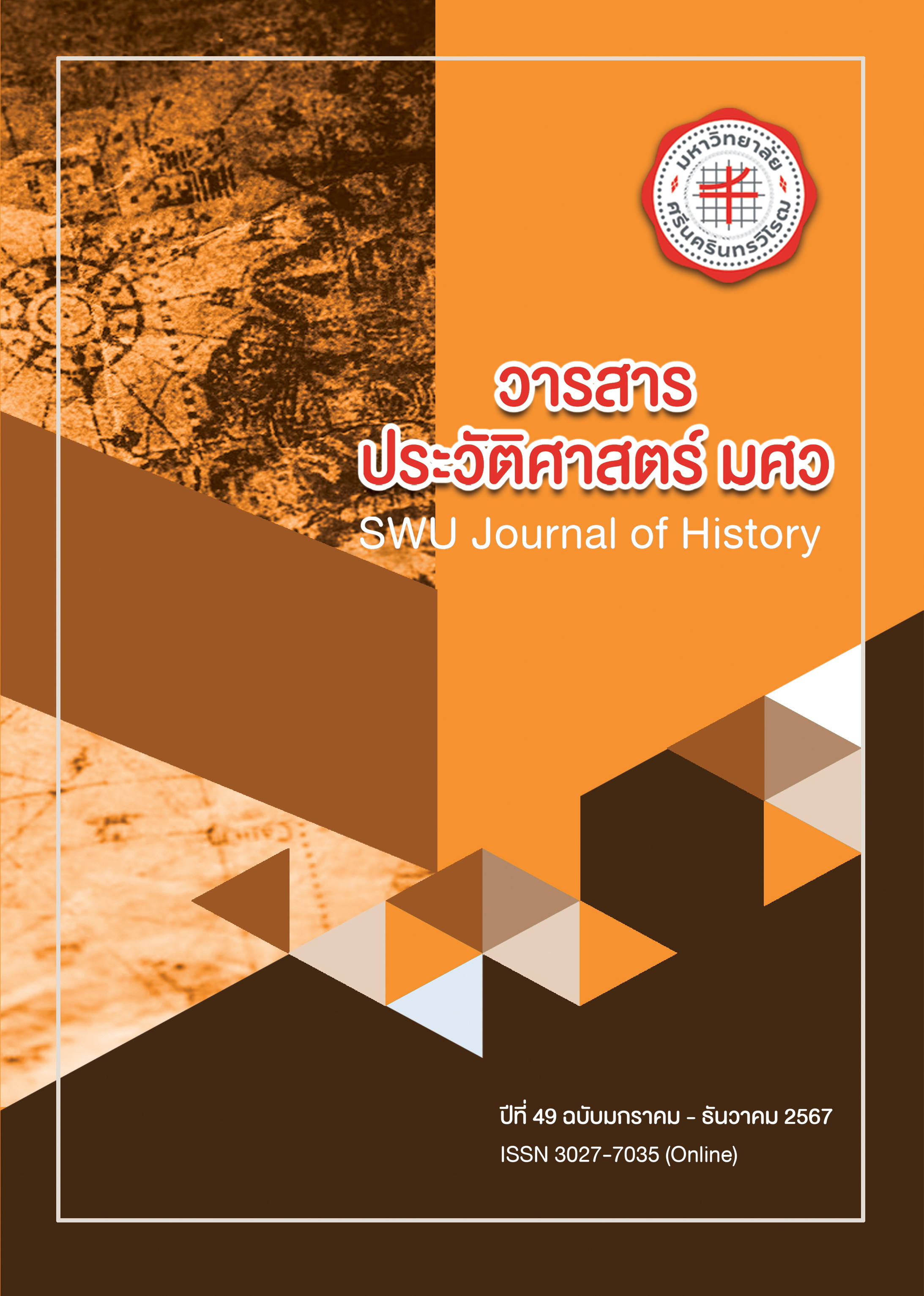The Culture of Japanese-style Idol Girl Groups’ Fans in Thailand During the Mid-2000s to 2020: A Case Study of AKB48’s and BNK48’s Fans
Main Article Content
Abstract
This article aims to study the culture of Japanese-style idol girl groups’ fans in Thailand during the mid-2000s to the year of 2020 by studying the case of AKB48 idol group’s fans and BNK48 idol group’s fans in order to understand the cultural changes among Japanese-style idol girl groups’ fans from the beginning period when entertainment cultures of Japanese idol industry were introduced to Thai people in the mid-2000s during the context of Cool Japan campaign – the Japan’s cultural strategy aiming to disseminate and export its pop cultures abroad to increase the country income. When the entertainment cultures of Japanese idol artists, namely AKB48, came into Thailand, subcultures emerged among the fans. These fans were characterized as “cultists” who consumed the artists’ merchandises and created a network of relationship within the fandom group. Later, in the mid-2010s, a Thai businessman bought the copyright from the Japanese company to found an idol girl group, BNK48, then a fandom was built. BNK48’s fans culture comprised both AKB48’s fans culture and its own unique culture developed in a specific context of Thai society. For example, BNK48’s fans applied a culture of “fan projects” from K-pop artists’ fans to support the BNK48 band. The fans were also “active consumers” which were different from the AKB48 fans in the previous period.
Article Details

This work is licensed under a Creative Commons Attribution-NonCommercial-NoDerivatives 4.0 International License.
References
หนังสือและบทความในหนังสือ
กาญจนา แก้วเทพ. (2555). “แฟนศึกษา ฉันมาแล้วจ้ะ”. ใน กาญจนา แก้วเทพ, ภัทรา บุรารักษ์, ตปากร พุธเกส. สื่อที่ใช่ ของที่ใครชอบ: การ์ตูน โทรทัศน์ท้องถิ่น แฟนคลับ. หน้า 292-509. กรุงเทพฯ: ภาพพิมพ์.
จินตวัฒน์ ศิริรัตน์ และ ภูวิน บุณยะเวชชีวิน. (2562). “วัฒนธรรมสมัยนิยมของญี่ปุ่น”. ใน สิทธิพล เครือรัฐติกาล (บรรณาธิการ). ญี่ปุ่นปัจจุบัน Japan Today. หน้า 291-330. ปทุมธานี : ศูนย์ญี่ปุ่นศึกษา สถาบันเอเชียตะวันออกศึกษา มหาวิทยาลัยธรรมศาสตร์
โดม ไกรปกรณ์. (2565). BNK48 วัฒนธรรมบันเทิงแบบใหม่ในสังคมไทยร่วมสมัย: ประวัติศาสตร์เชิงวิเคราะห์. กรุงเทพฯ: คณะสังคมศาสตร์ มหาวิทยาลัยศรีนครินทรวิโรฒ.
นรีนุช ดำรงชัย. (2562). ญี่ปุ่นยุคร่วมสมัย: การเปลี่ยนแปลงทางสังคม การเมือง เศรษฐกิจและวัฒนธรรม. กรุงเทพฯ: สำนักพิมพ์สถาบันบัณฑิตพัฒนบริหารศาสตร์.
พีรพิชญ์ ฉั่วสมบูรณ์. (2557). 12-4-48. กรุงเทพฯ : แซลมอนเฮ้าส์.
พีรพิชญ์ ฉั่วสมบูรณ์ และ ธัญวัฒน์ อิพภูดม. (2561). B side the untold story of BNK48. กรุงเทพฯ: แซลมอน.
ศิริพร ดาบเพชร. (2562). ประวัติศาสตร์เอเชียตะวันออกสมัยใหม่. กรุงเทพฯ: คณะสังคมศาสตร์ มหาวิทยาลัยศรีนครินทรวิโรฒ.
อรรถจักร์ สัตยานุรักษ์. (2548). Japanization. กรุงเทพฯ: openbooks.
BNK 48 2 ND ANNIVERSARY. (2562). กรุงเทพฯ: BNK 48 Office และ Mango Zero Team.
วิทยานิพนธ์และงานวิจัย
ชญานุตม์ พัฒนสุวรรณ. (2549). การรับวัฒนธรรมสมัยนิยมจากญี่ปุ่นของวัยรุ่น : กรณีศึกษาแฟนเพลงเจ-ป๊อป. วิทยานิพนธ์ ศศ.ม. (ญี่ปุ่นศึกษา). กรุงเทพฯ: มหาวิทยาลัยธรรมศาสตร์.
ธิดารัตน์ รักประยูร. (2545). การเผยแพร่วัฒนธรรมวัยรุ่นญี่ปุ่นผ่านสื่อในประเทศไทย. วิทยานิพนธ์ นศ.ม. (การสื่อสารมวลชน). กรุงเทพฯ: คณะนิเทศศาสตร์ จุฬาลงกรณ์มหาวิทยาลัย.
วิภารัตน์ พันธ์ฤทธิ์ดำ. (2544). อิทธิพลของวัฒนธรรมต่างประเทศที่มีต่ออัตลักษณ์ของวัยรุ่นไทย : ศึกษาเฉพาะกรณีดนตรีญี่ปุ่น. วิทยานิพนธ์ สค.ม. (สังคมวิทยา). กรุงเทพฯ: คณะรัฐศาสตร์ จุฬาลงกรณ์มหาวิทยาลัย.
ศิริพร ดาบเพชร. (2558). รายงานการวิจัยฉบับสมบูรณ์เรื่องการเปลี่ยนแปลงของสังคมญี่ปุ่นยุคหลังสงครามถึงปัจจุบัน. กรุงเทพฯ: คณะสังคมศาสตร์ มหาวิทยาลัยศรีนครินทรวิโรฒ.
สุรกิตติ์ สิงห์แก้ว. (2556). พฤติกรรมและอัตลักษณ์ความเป็นกลุ่มแฟนคลับ 48 Group ในกระแสวัฒนธรรมย่อย J-pop. รายงานการวิจัยหลักสูตรการวิจัยทางสังคม คณะสังคมวิทยาและมานุษยวิทยา มหาวิทยาลัยธรรมศาสตร์.
อาจินต์ ทองอยู่คง. (2555). “แฟนบอล” : ปฏิบัติการทางวัฒนธรรมของแฟนสโมสรฟุตบอลไทย. วิทยานิพนธ์ สม.ม. (มานุษยวิทยา). กรุงเทพฯ: มหาวิทยาลัยธรรมศาสตร์.
บทความ
“Special Interview จิรัฐ บวรวัฒนะ”. (2561, เมษายน). The Guitar Mag vol. 49,529: 76-79.
แหล่งข้อมูลอิเล็กทรอนิกส์
“ความสุขของติ่งวัยเกษียณ ‘ชัญญา ชโยภาสกุล’ ติ่ง BNK48”. (ม.ป.ป.). สืบค้นเมื่อ 21 เมษายน 2566, จาก https://www.manoottangwai.com/read/view/chanya-bnk48-fan-club-1/
“คำสารภาพของแฟนคลับรุ่นลุง “เธอรู้ไหมฉันเหมือน 14 อีกครั้งเพราะ BNK48””. (2561). สืบค้นเมื่อ 21 เมษายน 2566, จาก https://www.healthyliving.in.th/content/197403
“เซ่นดราม่า!! “ต้อม จิรัฐ – จ๊อบซัง” ประกาศยุติบทบาทบริหารวง BNK48”. (2563). สืบค้นเมื่อ 29 พฤษภาคม 2566, จาก https://www.pptvhd36.com/news
“เตรียมตัวให้พร้อม ก่อนไปคอนเสิร์ตใหญ่ BNK48 เสาร์-อาทิตย์นี้”. (2561). สืบค้นเมื่อ 24 ตุลาคม 2564, จาก https://www.mangozero.com/prepare-for-bnk48-concert/
“เต็มหน้าห้างฯ มีตติ้งแฟนคลับ "BNK48" นอนรอขอจับมือ!. (2561). https://www.newtv.co.th/news/14588.
“ถอดรหัสทางวัฒนธรรม ทุนนิยมและการเมืองผ่านเรื่องราวของ BNK 48”. (2021). สืบค้นเมื่อ 24 มิถุนายน 2564. จาก https://decode.plus/20210416/.
นนทิปัญจม์ ณัชชาณัฎฐ์. (2018). “โอนิกิริ-ปรากฏการณ์ปั้นความสุขของเหล่าโอตะที่อยากผลักดันไอดอล BNK48 ให้ถึงฝัน”. สืบค้นเมื่อ 21 เมษายน 2566. จาก https://adaymagazine.com/report-bnk48-phenomenon/
“เล่าที่มา ห้องสมุดเฌอปราง 1”. (2563). สืบค้นเมื่อ 21 เมษายน 2566, จาก https://pantip.com/topic/40205504
“เลือกตั้ง “BNK 48” สร้างรายได้ให้บริษัทเท่าไหร่ ? ”. (2019). สืบค้นเมื่อ 18 มกราคม 2564, จาก https://www.moneybuffalo.in.th/business
“สรุป 17 เหตุการณ์สำคัญหลัง BNK48 เปิดสมาชิกครบรอบ 1 ปี”. (2561). สืบค้นเมื่อ 28 ตุลาคม 2564, จาก https://www.mangozero.com/bnk48-1-year-anniversary/
“โอตะเคลื่อนไหวคึกคัก หลังผลด่วนเลือกตั้ง BNK48 “เฌอปราง” ที่หนึ่งตามคาด”. (2561). สืบค้นเมื่อ 21 เมษายน 2566. จาก https://www.pptvhd36.com/news/
Taweepong Sootpasanon. (2019). “สรุป Timeline เหตุการณ์สำคัญของ 48G Thailand”. สืบค้นเมื่อ 5 ตุลาคม 2563, จาก https://web.facebook.com/groups/1047840871943982
Tofupopradio. (2559). “เฟ้นหาวง BNK 48 ครั้งแรกของกรุงเทพฯในงาน # WENEEDYOUBNK48”. สืบค้นเมื่อ 10 พฤษภาคม 2563, จาก http://tofupopradio.becteroradio.com/activities/7304.
“#IAM48 ติดเทรนด์อันดับ 1 หลังแฟนคลับ ‘BNK48’ ไม่พอใจที่นำเธียเตอร์ของสาวๆ ไปใช้ในกิจกรรมของศิลปินอื่น”. (2020). สืบค้นเมื่อวันที่ 18 มกราคม 2566, จาก https://dudeplace.co/2020/02/17/iam48.
ภาพยนตร์
BNK48 Girl Don’t Cry. (2561). กำกับการแสดงโดย นวพล ธำรงรัตนฤทธิ์. ผลิตโดย บีเอ็นเคโฟรตีเอตออฟฟิศ, แซลมอน เฮ้าส์, แพลนบี มีเดีย, เวรี แซด พิคเจอร์ส.
สัมภาษณ์
พี่ที (นามสมมติ). สัมภาษณ์ (4 กันยายน 2565)
พี่ลุง (นามสมมติ). สัมภาษณ์ (7 เมษายน 2565)
เอ็ม (นามสมมติ). สัมภาษณ์ (26 พฤศจิกายน 2565)
ภาษาอังกฤษ
Monty, Aska. (2014). “MICRO Global music made in Japan ?”. in JAPANESE POPULAR CULTURE Critical Concepts in Asian Studies Volume III: Japanese Popular Culture in the Twenty-first Century. Edited by Alien, Matthew and Sakamoto, Rumi. pp. 151-158. London: Routledge.
Wolf, Fabienne Darling. (2014). “SMAP, SEX, AND MASCULINITY Constructing the perfect female fantacy in Japanese popular music”. in JAPANESE POPULAR CULTURE Critical Concepts in Asian Studies Volume III: Japanese Popular Culture in the Twenty-first Century. Edited by Alien, Matthew and Sakamoto, Rumi. pp. 159-175. London: Routledge.

